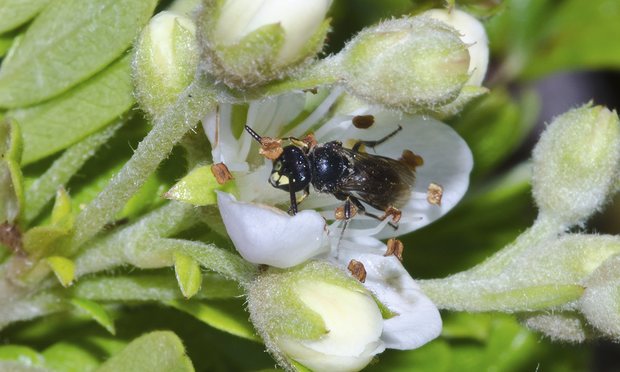Bees Added to US Endangered Species List for the First Time
ENVIRONMENT, 3 Oct 2016
The Guardian – TRANSCEND Media Service
Seven types of the yellow-faced or masked bees once found in great numbers in Hawaii are under threat, federal officials say.

A yellow-faced bee in Hawaii. They are at risk from habitat loss and non-native species. Photograph: John Kaia/AP
1 Oct 2016 – Seven types of bees once found in abundance in Hawaii have become the first bees to be added to the US federal list of endangered and threatened species.
The listing decision, published on Friday [30 Sep] in the Federal Register, classifies seven varieties of yellow-faced or masked bees as endangered, due to such factors as habitat loss, wildfires and the invasion of non-native plants and insects.
The bees, so named for yellow-to-white facial markings, once crowded Hawaii and Maui but recent surveys found their populations have plunged in the same fashion as other types of wild bees – and some commercial ones – elsewhere in the United States, federal wildlife managers said.
Pollinators like bees are crucial for the production of fruits, nuts and vegetables and they represent billions of dollars in value each year to the nation’s agricultural economy, officials said.
Placing yellow-faced bees under federal safeguards comes just over a week since the US Fish and Wildlife Service proposed adding the imperilled rusty patched bumble bee, a prized but vanishing pollinator once found in the upper midwest and north-eastern United States, to the endangered and threatened species list.
One of several wild bee species seen declining over the past two decades, the rusty patched bumble bee is the first in the continental United States formally proposed for protections.
The listing of the Hawaii species followed years of study by the conservation group Xerces Society, state government officials and independent researchers. The Xerces Society said its goal was to protect nature’s pollinators and invertebrates, which play a vital role in the health of the overall ecosystem.
The non-profit organization was involved in the initial petitions to protect the bee species, said Sarina Jepson, director of endangered species and aquatic programs for the Portland, Oregon-based group.
Jepson said yellow-faced bees could be found elsewhere in the world, but these particular species were native only to Hawaii and pollinate plant species indigenous to the islands.
The bees faced a variety of threats including “feral pigs, invasive ants, loss of native habitat due to invasive plants, fire, as well as development, especially in some for the coastal areas”, Jepson told Associated Press.
The bees could be found in a wide variety of habitats in Hawaii, from coastal environments to high-elevation shrub lands, she said. The yellow-faced bees pollinated some of Hawaii’s endangered native plant species. While other bees could potentially pollinate those species, many could become extinct if these bees were to die off entirely.
Hawaii-based entomologist Karl Magnacca said the bees “tend to favor the more dominant trees and shrubs we have here”, he said. “People tend to focus on the rare plants, and those are important, that’s a big part of the diversity. But the other side is maintaining the common ones as common. (The bees) help maintain the structure of the whole forest.”
The bees were critical for maintaining the health of plants and other animals across the islands, said Gregory Koob, conservation and restoration team manager for the Fish and Wildlife Service in Honolulu.
“Those plants are not only food and nesting habitat for the bees, but they also provide habitat for other animals,” he said. “It’s the web of life.”
_________________________________
More:
Plan bee: Minnesota sets broad limits on chemicals blamed for bee decline
Reuters and Associated Press contributed to this report.
Go to Original – theguardian.com
DISCLAIMER: The statements, views and opinions expressed in pieces republished here are solely those of the authors and do not necessarily represent those of TMS. In accordance with title 17 U.S.C. section 107, this material is distributed without profit to those who have expressed a prior interest in receiving the included information for research and educational purposes. TMS has no affiliation whatsoever with the originator of this article nor is TMS endorsed or sponsored by the originator. “GO TO ORIGINAL” links are provided as a convenience to our readers and allow for verification of authenticity. However, as originating pages are often updated by their originating host sites, the versions posted may not match the versions our readers view when clicking the “GO TO ORIGINAL” links. This site contains copyrighted material the use of which has not always been specifically authorized by the copyright owner. We are making such material available in our efforts to advance understanding of environmental, political, human rights, economic, democracy, scientific, and social justice issues, etc. We believe this constitutes a ‘fair use’ of any such copyrighted material as provided for in section 107 of the US Copyright Law. In accordance with Title 17 U.S.C. Section 107, the material on this site is distributed without profit to those who have expressed a prior interest in receiving the included information for research and educational purposes. For more information go to: http://www.law.cornell.edu/uscode/17/107.shtml. If you wish to use copyrighted material from this site for purposes of your own that go beyond ‘fair use’, you must obtain permission from the copyright owner.